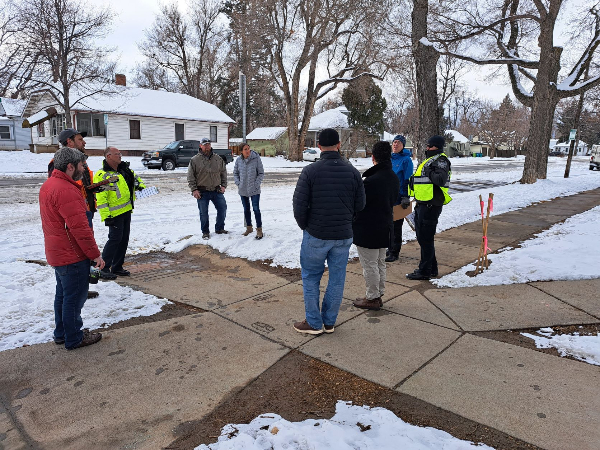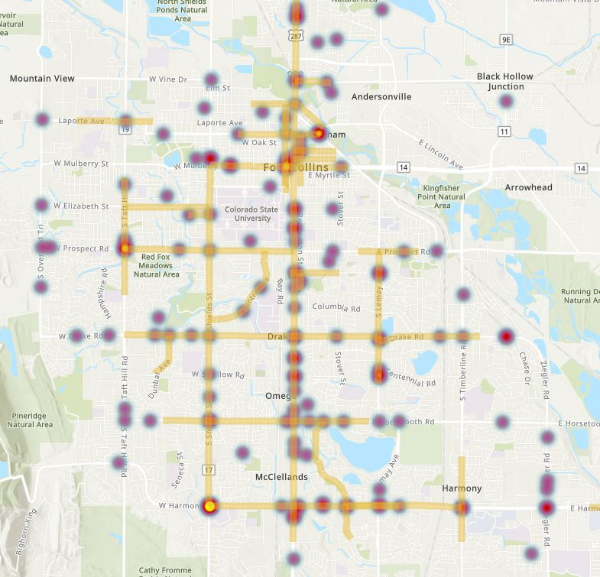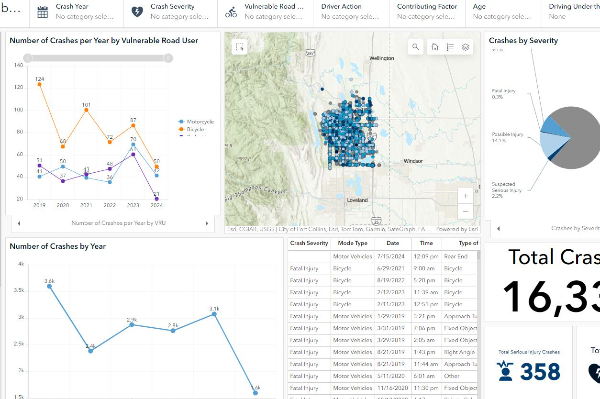
Eliminate traffic deaths and serious injuries#
What is Vision Zero?#
Roadside memorials and ghost bikes mark fatal traffic crashes. This ghost bike at Vine and Jerome memorializes a local bicyclist.
"Vision Zero" represents a commitment by the City of Fort Collins to work toward a total of zero fatal or serious-injury crashes on the city's transportation network. Design, safety, and consideration of all modes of travel all play a part in this effort, and the City has included Vision Zero principles in long-range transportation plans.
How is Fort Collins working toward Vision Zero?
The City of Fort Collins adopted the Vision Zero Action Plan in 2023. The plan identifies 10 specific actions for the City to take in the next 10 years to achieve Vision Zero by 2032 and eliminate fatalities and serious injuries on the city’s transportation network.
The Plan used a data-driven approach to identify crash trends and develop a High-Injury Network (HIN) where a disproportionate number of crashes led to fatalities and serious injuries. The actions in the Plan address safety issues in these crash trends and the HIN.
Why now?
Safety for all modes of transportation has always been a guiding principle for the City of Fort Collins. Vision Zero reflects the City's ongoing commitment to safety and will influence future decision making and funding opportunities.
Questions about Vision Zero? Contact Rachel Ruhlen rruhlen@fcgov.com (970) 685-8955
Further Reading: High Injury Network#
The Vision Zero Action Plan identified road segments in Fort Collins that had the greatest share of fatal and serious injury crashes. These segments together are referred to as the High Injury Network.
This network is based on a geospatial analysis of crash data from 2017 through 2021.
Arterial roads represent 91 percent of the HIN, collector roads represent 6 percent, and local streets represent only 3 percent. The HIN includes just 8 percent of the roads in Fort Collins, however, those roads account for 63 percent of all of the fatal and serious crashes.
Crash Dashboard#
This dashboard and interactive map updates nightly with completed traffic crash reports responded to by the City of Fort Collins Police Services. The dashboard does not include traffic crashes that are still under investigation. It also does not include crashes on private property or reported online to the Colorado Department of Revenue website (counter reports). Crash locations reflect the approximate location of the incident based on longitudinal and latitudinal information provided by the officer. Please note that the data and information on this dashboard is for informational purposes only. While we seek to provide accurate information, please note that errors may be present, and information presented may not be complete.
The Stories of Vision Zero#
The City would like to feature the personal stories that are why Vision Zero is so important. Have you experienced a life-changing injury or lost a loved one in a traffic crash in Fort Collins? Tell us about it in the form below.
You can help Fort Collins reach Vision Zero:
- Slow down when you are driving
- Provide input when we have opportunities
- Join us for a Vision Zero Site Visit
- Share your Vision Zero story
- and more!
Fill out the name and contact information fields in the form below to stay informed about Vision Zero opportunities.
Tell us your story in this form and/or provide your contact information if you'd like to learn more about how you can get involved in Vision Zero.
Existing Work Toward Vision Zero#
Traffic Safety#
The City's Traffic Operations Department is committed to its goal in achieving Vision Zero. The Annual Roadway Safety Report evaluates progress towards Vision Zero and the implementation of goals in the Fort Collins Vision Zero Action Plan. The report compiles traffic crash and safety information and tracks trends on public streets within Fort Collins. It analyzes intersection safety, evaluates safety on the High Injury Network, and evaluates previous work to identify project outcomes in terms of improving safety. The final section discusses specific next steps and provides safety-based work items for the City in the coming year.
Additional traffic safety information for the city is available at https://www.fcgov.com/traffic/safetysummary.
The full report is available for printing below. If you require assistance with reading/viewing the information provided in the PDF, please submit a Reasonable Accommodation Request and someone will be in touch to assist you. You may also call 970-221-6515 (V/TDD: Dial 711 for Relay Colorado) for immediate assistance.
City Planning#
City planning documents include Vision Zero principles. Learn more about some of these recent efforts below.
Vision Zero Evaluation#
This document has recommended metrics for assessing progress on the Vision Zero Action Plan.
Vision Zero Site Visits#

Neighbors, staff, and community members review the intersection on a snowy day
Community members, city staff, and other organizations regularly meet at locations of interest for Vision Zero Site Visits. These may be locations with a severe crash history or locations of concern for potential severe crashes. During these meetings, participants experience and observe the infrastructure and consider the experiences of people traveling through on foot, bicycle, or motor vehicle. They consider how people with disabilities experience the infrastructure. They review traffic volume and other data.
The observations and insights gathered from these Vision Zero Site Visits is shared with decision makers who can implement projects, programs, and policies.
You can review the notes from past Vision Zero Site Visits:
2023 07 13 College and Laporte
2023 05 04 Drake and Lemay
2023 03 20 Lemay and Centennial
2023 01 23 Magnolia and Loomis
Transportation Capital Projects Prioritization Study#
Transportation Capital Projects Prioritization Study was an effort by the City to analyze safety and congestion data for intersections and arterial roadways within Fort Collins and its Growth Management Area in unincorporated Larimer County. The study provided a prioritized project list to guide the City and County as they develop capital improvement plans and seek funding to improve the transportation network.
Public engagement was completed in early 2022. The final study is available here.
Active Modes Plan#
Active Modes Plan#
The Active Modes Plan was adopted in December 2022. The plan combines the City's 2011 Pedestrian Plan and the 2014 Bicycle Plan into one planning document. The goal is to make it easy, safe, and attractive for people of all ages and abilities to use active modes of transportation.
Bicycle & Pedestrian Grade Separated Crossings Study#
In 2018, the City completed its Bicycle & Pedestrian Grade Separated Crossings Study, which is meant to help the City prioritize bicycle and pedestrian grade separated crossings to increase safety and reduce conflicts among modes of travel.
The study established an approach to prioritize candidate bicycle and pedestrian grade separation locations to direct future investment towards locations that need it most using a data driven approach using both data and engineering judgment. The prioritization process included:
• Crossing opportunities identification
• Evaluation criteria identification and definition
• Data compilation
• Screening and prioritization according to the benefits generated for the bicycle network and
the community.
Vision Zero in Other Communities#
Numerous cities, counties, states, and countries have made similar commitments under the Vision Zero banner since Sweden became the first country to make such a commitment in 1997.
Elsewhere in Colorado, several of our neighboring communities also have Vision Zero initiatives, including Denver, Boulder, and the Denver Regional Council of Governments.
The Colorado Department of Transportation also began its "Moving Toward Zero Deaths" initiative in 2015, and in 2016, Fort Collins was the first municipality to join the initiative.


